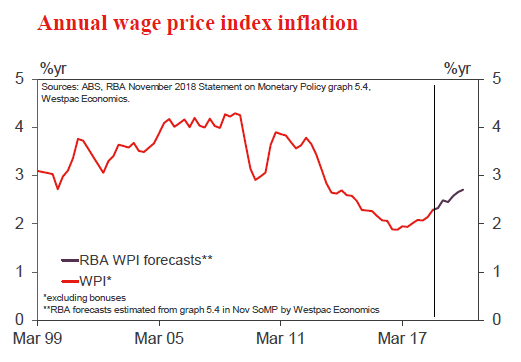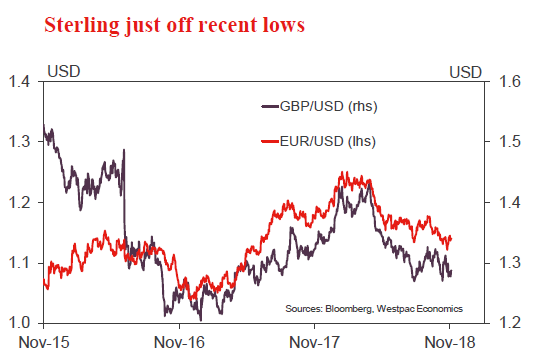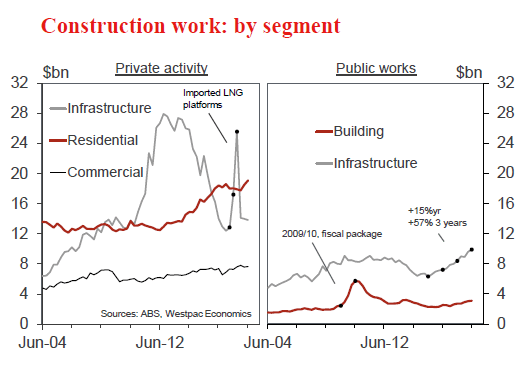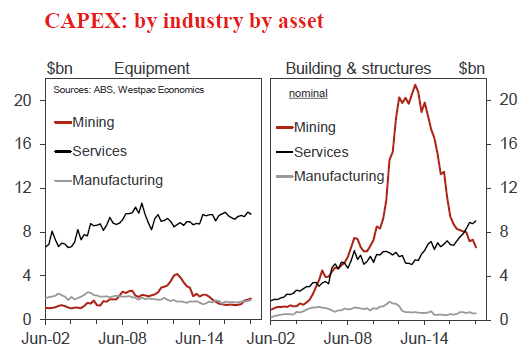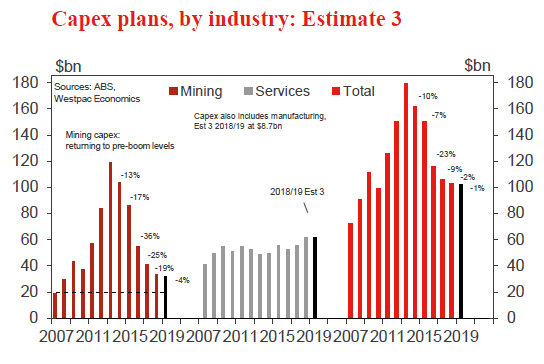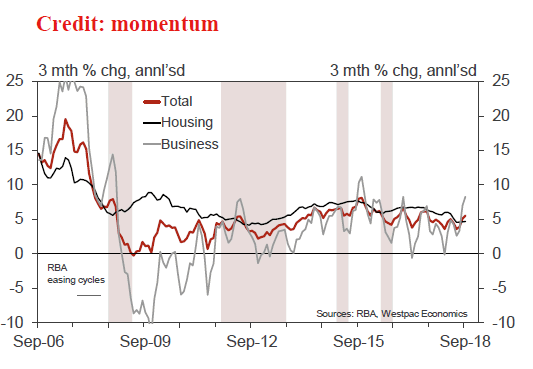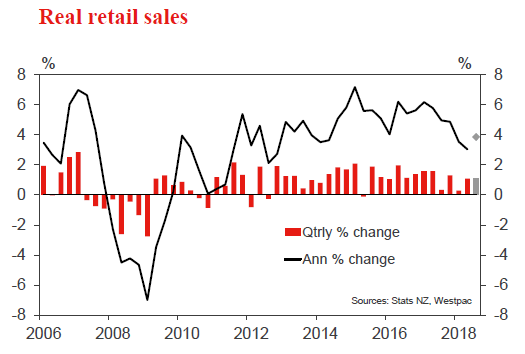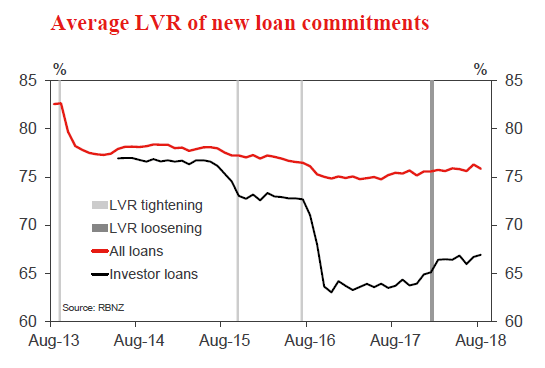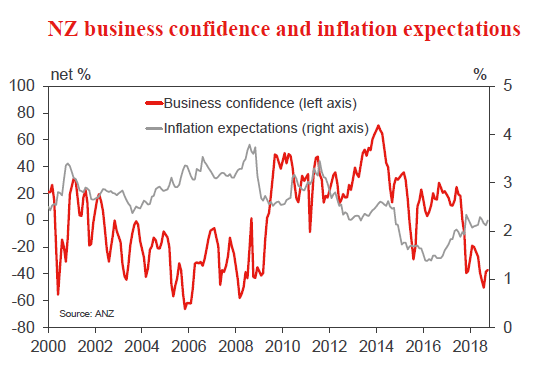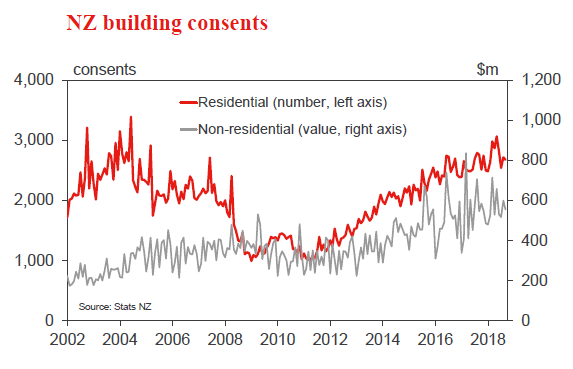Week beginning 26 November 2018
- RBA’s forecast for wages casts doubt on their confidence of a hike by end 2020.
- RBA: Governor Lowe and Assistant Governor Kent speak.
- Australia: capex survey, construction work done, private credit.
- NZ: RBNZ Financial Stability Report, retail sales, business confidence, residential building consents.
- China: NBS PMI’s.
- Europe: CPI, unemployment, ECB President Draghi speaks.
- US: Fed Chair Powell speaks, FOMC minutes, GDP 2nd estimate.
- Key economic & financial forecasts.
Information contained in this report current as at 23 November 2018.
RBA’s Forecast for Wages Casts Doubt on Their Confidence of a Hike by End 2020
The minutes of the November monetary policy meeting of the Reserve Bank Board confirm the confident approach we have seen in the recent Statement on Monetary Policy.
While consumption growth is still identified as a source of uncertainty, the Board expects it to remain around the 3% level over the next few years that we have seen recently. Household disposable income growth is also forecast to increase at that rate.
GDP growth and labour market conditions have been stronger than the RBA had expected over the last twelve months. Accordingly, the forecast for the unemployment rate has been lowered to 4 ¾ per cent from 5 per cent by mid-2020, with an implied downside risk to that forecast. With the improved labour market outlook, there has been a modest upward revision to the outlook for wages growth. This is a particularly encouraging development for the RBA as they see wages growth as the key uncertainty for future consumption growth and inflation.
In that regard, the forecast for inflation has been lifted modestly, reflecting the brighter outlook for economic activity, the labour market and wages.
Non-mining business investment was expected to continue to make a significant contribution to output growth supported by above average business conditions and the significant pipeline of non-residential construction work.
Their discussion around the housing market is less confident. Residential building approvals are recognised to have fallen in the September quarter and liaison with builders describes a difficult picture. Furthermore, it is noted that housing prices have fallen further in Sydney and Melbourne, although are stable in most other cities. With the RBA’s core forecast that consumption and income growth will be aligned, there is no allowance for any negative wealth effects from these housing developments.
The minutes discuss the various policy stances of other central banks noting that “market pricing was consistent with policy rates remaining steady over the following year in Australia and New Zealand, where policy rates had not been lowered to the extent they had in some other economies”.
The Board also discussed the RBA’s forecasting performance over the previous year, noting that forecast errors were smaller than historical averages with GDP growth and business investment surprising to the upside, the terms of trade average being higher than expected, and the marked depreciation in the Australian Dollar. Labour market outcomes were also stronger than expected, although wages growth and inflation had evolved largely as expected.
Consequently their success in the forecasting of inflation and wages despite underestimating employment and growth forecasts is a result that would have puzzled the forecasters.
The conclusion has been that the lags between growth; unemployment; and wages/inflation are larger than had been expected.
The question is just how long are these lags?
Westpac is expecting growth to slow down in 2019 and the unemployment rate to move back to 5.3% through mid- 2019. That development would interrupt the steady gradual improvement the RBA is expecting.
This expected gradual lift in wages growth represents the key to the RBA’s expectation for higher rates. The importance of wages in boosting incomes and inflation is paramount in the RBA’s thinking so it is instrumental to get an insight into just how quickly the RBA expects wages growth to lift. Note the comments in the minutes that Australia requires “a gradual increase in wages growth for inflation to be sustainably within the target range”.
That outlook was provided in a graph (reproduced from the November Statement on Monetary Policy) where the RBA’s own forecasts for annual growth in the Wage Price Index are presented for the first time.
We are not given the point estimate by end 2020 but it certainly “eyeballs” at comfortably below 3%. (arguably around 2.75%).
Consider the growth rate of the WPI at the point of the beginning of the previous five rate hike cycles.
The start dates of the five previous rate hike cycles were May 2002; November 2003; May 2006; August 2007; and October 2009.
The latest WPI prints at the time of those meetings were an annual pace of 3.5% in December 2001; 3.2% in June 2002; 4.1% in December 2005; 4.0% in March 2007 and 3.7% in June 2009.
These are much faster growth rates than the RBA is expecting by end 2020 raising the question as to whether despite the confident assertion that the next move in rates is likely to be up, the RBA is anticipating such long lags between growth and wages/inflation that it will be surprised if the case to raise rates will even be clear by end 2020.
The RBA itself might be expecting to continue with “there was no strong case for a near-term adjustment in monetary policy” for a lot longer than is commonly assumed.
There may be other surprise developments such as a rapid fall in the Australian dollar which would trigger a response from the RBA. However, its forecast of a gradual build up of wage pressures indicates that they expect to be patient for a lot longer than generally believed.
The week that was
The RBA’s minutes from their November meeting and a subsequent speech by Governor Lowe carried a confident but unhurried tone. Meanwhile the US economy showed early signs of the slowdown in activity that we anticipate will take growth back to trend over the coming year.
Beginning with the RBA, though the consumer is still seen as a ‘source of uncertainty’, the Board is more confident in the sector’s outlook.
In the RBA’s view, on the back of strong gains for employment and a nascent acceleration in wages growth, consumption is set to support above-trend growth through 2019 and 2020, along with strength in infrastructure investment and non-residential construction. With the savings rate near historic lows, this requires an acceleration in income growth to the 3.0% annual pace currently being seen for consumption.
We remain unconvinced on growth, instead anticipating that it will slow back to trend in 2019. Housing and the consumer are critical to this view. On housing, in contrast to the RBA, Westpac anticipates that GDP will be materially affected by declining residential investment – a trend increasingly evident in dwelling approvals.
On top of this investment effect, further declines in house prices will reduce household wealth and, we believe, impede consumers’ willingness to spend. Consumers’ spending capacity also continues to be restricted by a very modest wage uptrend, with full employment remaining elusive. The above outturn would clearly warrant the RBA remaining on hold not only through 2019, but also 2020.
Confidence in the real economy is also critical for the US. There the market has taken recent communications by FOMC officials as dovish overall, resulting in a paring back of nearterm expectations for policy. For us, the ‘dovish’ remarks of the Committee are merely recognition that neutral is nearing and the growth cycle maturing, not that policy will shift abruptly.
Westpac remains of the view that, following a rate hike at their December meeting, the FOMC will increase the federal funds rate a further three times in 2019 to a September peak of 3.125%. At this level, the stance of policy will be mildly contractionary, but still accommodative enough to allow growth to persist at trend given the underlying strength of the US labour market.
October’s weak durable goods orders and shipments update was in line with our view that growth in business investment will weaken over the coming year.
However, as long as the consumer remains robust, which labour market strength and household wealth currently point to, the FOMC is unlikely to waver. Global risks are being watched, but will only affect policy if/ when they threaten domestic momentum.
Across the Atlantic, Brexit remains the focus. Negotiations achieved enough this week to allow the EU Summit on the matter to go ahead this weekend, but the key event to watch out for remains the UK parliament’s vote to pass or reject the current draft deal. On that matter there remains considerable uncertainty.
For Europe more broadly, there was a subtle change in the ECB’s November meeting minutes. Risks continue to be considered broadly balanced with the broad-based expansion still intact, but a remark was made by a member “that a number of arguments pointed towards risks to the growth outlook tilting to the downside”.
The ‘balance of risks’ will gain greater prominence in 2019 as the first rate hike of the cycle (potentially) comes into view.
Before closing out for the week, our New Zealand economics team has just released their latest quarterly update. Notable in this edition is the unusual pairing of stronger NZ GDP and inflation forecasts with softer RBNZ cash rate and currency profiles. Reconciling this divergence, it is increasingly evident that the RBNZ’s behaviour has changed, with the cash rate kept lower for longer than the RBNZ of old would have. See the following NZ page for further detail.
Chart of the week: draft Brexit proposal
PM May is currently seeking approval for a draft exit agreement. The proposal detail implies a ‘soft’ Brexit that would keep the UK closely linked to the EU – at least temporarily. Key aspects of the draft proposal include:
- A transition period through to December 2020 where the UK will remain within the EU customs union.
- The transition period avoids the need for a hard border between Ireland and Northern Ireland, but it also means that the UK will be required to adhere to EU regulations without a capacity to influence them.
- Financial service providers based in the UK are likely to have reduced ability to operate within the EU.
- The existing rights of EU citizens in the UK and UK citizens residing in the EU have been maintained, allowing freedom of movement while new arrangements are agreed.
New Zealand: week ahead & data wrap
Stranger things
This week we released our latest Economic Overview. In it we highlight what may at first sound like an unusual set of changes in our forecasts. We’re now expecting stronger economic growth and a faster pick-up in inflation than we previously forecast. But despite the firming on both of these fronts, we actually expect that the Reserve Bank is going to remain on hold for longer than we previously assumed, and have pushed out our forecast for Official Cash Rate hikes to November 2020 (back from May 2020 as we previously expected). So what’s behind this change in the outlook?
Looking first at real economic activity, recent months have seen the New Zealand economy catching a second wind, with GDP growth set to rise to rates a little over 3% through 2019. This pick-up is something we had long been forecasting, despite the pessimistic tone of some business surveys. It was pretty much inevitable, given the large increases in Government spending being rolled out, and it has been reinforced by a lift in construction activity. Demand is also being buoyed by the recent drop in fixed mortgage rates, which has boosted the housing market and household spending.
We still expect that the current firmness in activity will give way to a period of slower growth as we head into the early-2020s. Previous drivers of demand, like population growth and the construction cycle, have now moved into new phases, and going forward they won’t provide the same boost they once did. In addition, house price growth is set to slow again over the coming years, with a battery of demand-dampening policy changes already in place or on the horizon.
On the prices front, headline inflation is now set to rise to 2.2% in early-2019. However, much of that rise is due to earlier increases in petrol prices, which are only providing a temporary lift in inflation. In fact, we’ve already seen some sizeable falls in fuel prices in recent weeks, which will dampen headline inflation going forward.
Looking through the short-term volatility in fuel prices, we are seeing signs that inflation pressures more generally are building in the economy. Most notably, a growing number of businesses have highlighted increased cost pressures, particularly with regards to wages. Combined with a lower NZ dollar and firmness in demand, we expect that this will push inflation higher over the coming year.
But even accounting for those factors, inflation is only set to rise slowly, with underlying inflation expected to rise from around 1.7% now to a little over 2% in 2020. That’s because there are still some big factors limiting the rise in overall inflation. The most important is the continuing strong competitive pressures in the retail sector. We’re also seeing more moderate increases in some Government charges (such as tertiary education) than we did in the previous decade, and that pattern is likely to continue for some time.
The above factors mean that we expect inflation will remain well contained within the RBNZ’s 1 to 3% target band over the next few years, albeit at rates that are a little above 2%. We certainly don’t think that inflation will rise to levels that would spook the RBNZ into hiking rates any time soon. In fact, the RBNZ’s recent communications have highlighted that, since the adoption of its new duel mandate, it is now more willing to tolerate some rise in inflation above the target mid-point in order to shore up growth. That dovish lurch was evident in the RBNZ’s recent policy statement, which both showed higher growth and inflation settling a little above 2%, but absolutely no change in the accompanying interest rate projection. With this in mind, we are now forecasting later and more gradual OCR hikes than we previously expected.
With inflation currently well contained, this approach will work fine for the RBNZ over the next few years. But over time, we could see inflation expectations creeping higher. That would then mean the Reserve Bank has to maintain higher nominal interest rates to achieve the same real interest rate and keep inflation steady.
The price of milk
The other key development this week was yet another drop in global dairy prices. Prices fell 3.5% in the latest auction and have now fallen 20% since their May peak.
While concerns about the strength of global demand are swirling at the moment, the big factor weighing on prices is the strong growth in domestic milk production. Milk collections were up 6.5% in October compared to last year, and season to date production is up 6%. That’s well ahead of what we or Fonterra expected. In addition, pasture conditions are looking good as we head into the summer months.
Increases in production and the related drop in prices have added to the downside risk for this season’s farmgate payout. We have long forecast a $6.25/kgMS farmgate milk price for the 2018/19 season. However, that forecast was contingent on some rise in milk auction prices over the coming months. And with production so strong, there is clearly downside risk to our forecasts. Certainly, Fonterra’s forecast $6.25 to $6.50 is looking increasingly unrealistic.
While prices may be softening, we wouldn’t describe this as a negative for New Zealand farmers. Despite lower prices, higher volumes will support farmgate returns. And importantly, prices remain well above breakeven levels for most farmers.
Data Previews
Aus Q3 construction work
- Nov 28, Last: 1.6%, WBC f/c: 0.6%
- Mkt f/c: 0.9%, Range: -2.5% to 2.0%
Construction work grew by a robust 1.6% in Q2. Gains were evident across public works, new home building and commercial building. There was a modest decline in private engineering activity, as well as a dip in home renovations.
For the September quarter, we anticipate a more modest lift in construction work, up a forecast 0.6%.
Notably, new home building activity is expected to consolidate after a brisk 4.1% rise in Q2. Approvals have retreated although a sizeable work pipeline remains.
Public works is a source of growth, +2.5% in Q2 and up a forecast 3% in Q3, with a focus on transport infrastructure.
Elsewhere conditions are likely to be mixed, with the risk of a small decline in private engineering and a modest gain in commercial building work.
Aus Q3 private business capex
- Nov 29, Last: -2.5%, WBC f/c: 0.4%
- Mkt f/c: 1.0%, Range: -0.5% to 3.0%
Private business capex spending was mixed over the first half of 2018, down 2.5% in Q2 after a 1.2% rise in Q1.
This followed a 4.2% rise in capex in 2017, after four years of decline, on a diminished drag from the mining investment wind-down and with non-mining investment trending higher.
For Q3, we expect a soft result, up only 0.4%.
Building & structures is expected to be broadly flat. Commercial building up a little, supported by a sizeable work pipeline but with approvals off their highs. Infrastructure down a little with gas projects completed but other projects (roads and iron ore) getting underway.
Equipment spending is forecast to rise by 0.8%, reversing a 0.9% fall in Q2, to be 5% above the level of a year ago – supported by rising profits and higher capacity utilisation levels. Service sectors are lifting spending but growth is choppy and the underlying pace is modest of late.
Aus 2018/19 capex plans
- Nov 29, Last (Est 3 for 2018/19): $102bn, -1%
This survey, conducted in October and November, includes the 4th estimate of capex spending plans for 2018/19.
In the previous survey, Est 3 for 2018/19 was $102bn, some 1% below Est 3 a year ago. By industry, Est 3 on Est 3 points to mining capex in 2018/19 being lower than in 2017/18 (with the completion of the gas projects) and broadly flat capex across the non-mining economy.
For Est 4 on Est 4 to be at -1% (matching the Est 3 outcome) would require an upgrade of 6% to $108bn – an upgrade which is in line recent historical experience, including last year. Accordingly, an Est 4 of $108bn is plausible, with risks potentially tilted to the upside.
Our central case forecast is for business investment to edge higher in 2018/19, up 1%. This is supported by sectors (education and health) and assets (computer software) excluded from the capex survey. That is, the capex survey understates the outlook for business investment.
Aus Oct private credit
- Nov 30, Last: 0.5%, WBC f/c: 0.4%
- Mkt f/c: 0.4%, Range: 0.3% to 0.5%
Private sector credit growth has been relatively modest over the past year at 4.6%, moderating from 5.3% a year earlier as the housing sector cools.
However, in the September quarter, growth lifted to a 5.5% annualised pace centred on a burst of business lending, running at 8.3% annualised for the period. For October, we expect a 0.4% gain, matching the September outcome.
Housing credit, at this late stage of the cycle, is slowing as tighter lending conditions see new lending decline, particularly for investors. In September, housing credit grew by 0.4%, 5.2%yr (including investors, at 0.1%mth, 1.4%yr).
Business credit, 4.4% above the level of a year ago, is volatile around a modest uptrend as businesses increase investment in the real economy. Commercial finance strength of late points to a robust outcome for October.
NZ Q3 real retail sales
- Nov 26, Last: +1.1%, Westpac f/c: +1.0%, Mkt f/c: +1.1%
Adjusted for price changes, retail spending rose by 1.1% in the June quarter. Strength was seen in several areas, with spending in core categories (which excludes the volatile vehicle and fuel components) up a strong 1.4%.
We expect to see another solid increase in retail volumes of 1.1% in the September quarter, including a 2% increase in the core categories.
Monthly nominal spending figures posted solid gains over the September quarter, buoyed by increases in government transfer payments to households. However, recent months also saw strong increases in fuel prices, which squeezed households’ disposable incomes and limited the rise in overall spending.
NZ RBNZ Financial Stability Report
- Nov 28
The RBNZ’s six-monthly review of the financial system will include a review of the loan-to-value (LVR) restrictions on mortgage lending. Last November the RBNZ eased the restrictions slightly, and indicated that further easing was possible if house prices and credit growth remained in check.
We have long been of the view that these criteria would be met. Government policies (such as extending the ‘bright line’ test and restricting foreign buyers) and changes in lending practices are now doing some of the prudential work that the LVR restrictions once did on their own.
We would expect any changes to be incremental. The RBNZ has said that it will look to reduce the LVR limits to ‘neutral’ levels, rather than remove them altogether.
NZ Nov business confidence
- Nov 29, Last: -37.1
Business sentiment has improved marginally in the last two months, but it remains at very low levels.
Prospects for the November survey look mixed. Fuel prices have fallen sharply in the last month, providing some relief in terms of both business costs and consumers’ spending power. However, confidence in the agricultural sector may worsen further, given to the deteriorating outlook for farmgate milk prices.
While we expect some drag on business investment in the short term, our view remains that overall activity is much more robust than the confidence surveys would imply. The 1% rise in June quarter GDP was boosted by some temporary factors, but we expect solid gains of 0.7-0.8% in the next two quarters.
NZ Oct residential building consents
- Nov 30, Last: -1.5%, WBC f/c: -5%
Residential dwelling consent issuance fell by 1.5% in September. However, that only partially offset earlier increases, and still left consent issuance at elevated levels.
We expect to see a further 5% decline in residential consent numbers in October. That decline is expected to be centred on Canterbury, and follows an unexpected lift in September. Building activity in Canterbury is continuing to gradually ease back following a period of very strong activity in the wake of 2010 and 2011’s massive earthquakes.
Consent numbers in other regions are expected to remain firm. In Auckland, where most of the increase over the past year has been centred, issuance levels are expected to remain very strong (around 13,000 on an annual basis).




